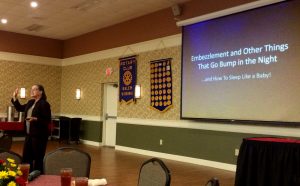Club Meeting – May 26, 2016
 Embezzlement and Other Things That Go Bump in the Night.
Embezzlement and Other Things That Go Bump in the Night.
– Susan Culbertson
Susan Culbertson is a CPA who has for more than 20 years, has owned Controllers, Etc., a resource for all things related to internal corporate accounting. She is the past National Director and Regional Vice-President of the Institute of Management Accountants and is a writer for business publications covering accounting and business management topics.
Susan presented to the Rotary Club of Salem, a compelling presentation on embezzlement that happens often in private companies, corporations and not-for-profits/associations alike. Susan began by profiling the most likely employee that would be involved with embezzlement. It is not what someone would typically associate with this criminal activity but is a middle-aged white male who is trusted, hardworking, dedicated, helpful and keeps to himself. This sounds like the perfect employee as it could be anyone who is trusted with all-access, so dedicated that they are unable to leave for any time off, very helpful in effort to stay in the know and an employee who keeps to themselves.
Susan outlined a recipe for fraud which consists of motive such as money for gambling or sick relative, rationalization as in they need the money more than their employer and opportunity as in easy access to company’s funds or a signator for the company.
Some of the points Susan had outlined are as follows:
While we may think that our greatest losses in business can come from shoplifters or hold-up robbers, our greatest risk within a company is the embezzler. Embezzlers attack a third of all businesses, maybe more if all of the embezzlements were reported.
Embezzlers do not look like the stereotypical thief. Instead, they look like our best friends, our Sunday School teacher, our business confidant—because maybe they are. These are people in their 40s, 50s, and 60s who:
- have earned our trust,
- are hardworking, dependable, and helpful, and
- do not need supervision.
Yet, they have access to everything in the financial realm of the business and may display the other attributes because they are actively working and concealing the fraud.
The Fraud Triangle consists of three parts that are all required to allow a fraud to happen—Motive, Rationalization, and Opportunity. While gambling debts, family medical issues, and drug use may be the expected motive for stealing, the number one reason is “keeping up appearances”. The only part that the employer controls is the Opportunity. Eliminating the opportunity protects both the employer and the employees.
Ways to limit the opportunity for fraud in a company involve:
- knowing your security weaknesses,
- building an infrastructure of Internal Controls to combat those weaknesses,
- being actively involved in financial oversight, and
- keeping the lines of communication open with all of your employees.
Susan summed up by giving some tips on how to deter this crime which are to separate duties, limit cash activity, trust but verify, look at originals, and a tip line where someone would be able to report this activity anonymously. Very helpful concepts to help businesses and associations to combat embezzlement and will help you to “sleep like a baby!”. The meeting adjourned after the 4 Way Test.


